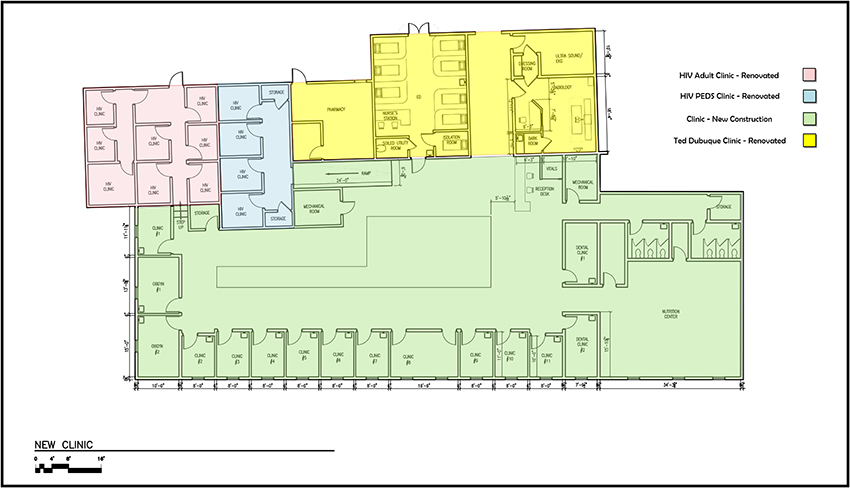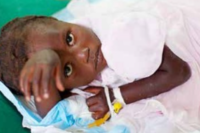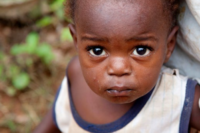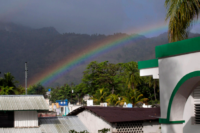
Plans for the massive $890,000 outpatient clinic project followed months of needs and site analysis, surveys, and consultation with construction, engineering, medical and hospital administration experts.
Hôpital Sacré Cœur began its life as a small 8 bed clinic, built stone by stone by local residents under the gentle guidance of the Sacred Heart Brothers of Montreal. It was often the case that late night surgeries and other procedures were illuminated by kerosene lamps clutched in the hands of anxious family members. Entrusting those early medical volunteers from America with the hopeful fate of their loved ones, the townspeople began a long and enduring bond with the little hospital that was destined for bigger things.
That was almost thirty years ago and what had begun as an adjunct to the brothers’ social justice undertaking has now become the keystone to quality healthcare in the Northern Province.
 Fast forward to 2014, and though the line of men and women carrying rocks from a nearby river bed has been replaced by modern construction materials and methodologies, the employment of scores of Milotians continues in the rich tradition of yesteryear. Young men, who live in an area of great poverty and an even greater dearth of gainful employment, labor under the torrid Haitian canopy while applying their muscle and might to a new, wonderful vision taking shape before their eyes.
Fast forward to 2014, and though the line of men and women carrying rocks from a nearby river bed has been replaced by modern construction materials and methodologies, the employment of scores of Milotians continues in the rich tradition of yesteryear. Young men, who live in an area of great poverty and an even greater dearth of gainful employment, labor under the torrid Haitian canopy while applying their muscle and might to a new, wonderful vision taking shape before their eyes.
 A twenty-six room outpatient clinic is being constructed on one acre of land that was purchased from our long time neighbor, Mr. Herman Etienne, in 2011. Where goats milled about the stumps of Bwa Soumi and Fwenn trees cut for charcoal and skipped over outcroppings of ancient sedimentary rock, there now stands a smooth concrete base supporting an evolving structure.
A twenty-six room outpatient clinic is being constructed on one acre of land that was purchased from our long time neighbor, Mr. Herman Etienne, in 2011. Where goats milled about the stumps of Bwa Soumi and Fwenn trees cut for charcoal and skipped over outcroppings of ancient sedimentary rock, there now stands a smooth concrete base supporting an evolving structure.
The new clinic will meld the small 900 square foot Ted Dubuque building, built in the late 1980’s, which currently houses our OB-GYN outpatient rooms and the radiology department, into 9,000 square feet of multidiscipline medical uses.
Instead of relying upon the traditional stone foundations, hand formed, sun baked concrete blocks and poured cement roof structures, we took an innovative approach to the construction materials used for this facility.
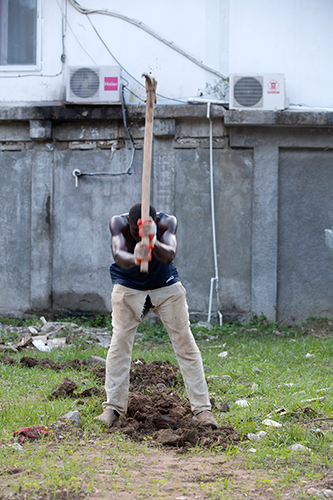 With the tragic events of January 2010 as our backdrop, where upwards of 300,000 Haitians perished in one of the most horrific human tragedies of our lifetime, we opted for the use of more earthquake resistant products. The basis for the design was a single story building comprised of light weight structural steel studs and EPS or Extruded PolyStyrene foam wall panels, a product similar to Styrofoam.
With the tragic events of January 2010 as our backdrop, where upwards of 300,000 Haitians perished in one of the most horrific human tragedies of our lifetime, we opted for the use of more earthquake resistant products. The basis for the design was a single story building comprised of light weight structural steel studs and EPS or Extruded PolyStyrene foam wall panels, a product similar to Styrofoam.
There are many advantages to this type of construction; the most obvious is the low impact to potential crush victims during an active earthquake event. In addition, the building system has very good insulating qualities which shield its occupants from the often extreme heat of the Haitian summers. It is insect proof, fire resistant, will not rot under the most extreme weather conditions and is very easily repaired in the event of accidental damage. The system was purchased from Veerhouse Voda, an innovative Dutch company located in Volendam, The Netherlands. The construction and outfitting of this new facility is expected to be completed in the spring of 2014.
The constant stream of outpatient visits which reached nearly 45,000 in 2012 will now have the added benefit of space and improved flow to accommodate the growth that has steadily increased since the Sacred Heart brothers arrived in Milot in the 1960’s.
Need is a nebulous thing to evaluate. Reading the published stats on the scarcity of medicine, the lack of effective governance and the scope of poverty and hunger in Haiti leads us to look for subjective answers that may encourage us to continue to struggle against formidable odds.
In the case of Hôpital Sacré Cœur, we can see that progress has been made in spite of those statistics and that in some cases we are witnessing the beginnings of sustainability.

 The new clinic is one of those initiatives that will bear immediate fruit. It has the promise of adding efficiency through its design and extended “useful life” components. It will take little energy to keep lighted and cooled. It reduces the need for cyclical painting to protect and waterproof the clinic salles. It also allows for patient privacy and dignity during an exam, a root on the tree of human empowerment.
The new clinic is one of those initiatives that will bear immediate fruit. It has the promise of adding efficiency through its design and extended “useful life” components. It will take little energy to keep lighted and cooled. It reduces the need for cyclical painting to protect and waterproof the clinic salles. It also allows for patient privacy and dignity during an exam, a root on the tree of human empowerment.
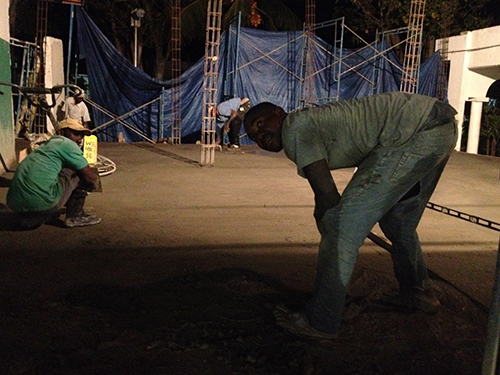 For those senior residents of Milot and the surrounding countryside who have grown up with the unwritten contract of love and support between the “givers” from America and themselves, this clinic represents a major achievement.
For those senior residents of Milot and the surrounding countryside who have grown up with the unwritten contract of love and support between the “givers” from America and themselves, this clinic represents a major achievement.
For almost 30 years, there has been a growing influx of attending angels. Initially through the efforts of the Sacred Heart brothers, then doctors, nurses and non-medical people from across the land, they all came into the small village in the valley at the foot of San Souci Palace to honor a commitment to improve the lives of the forgotten children of God’s family. At the onset of this New Year, we proclaim our thankfulness to all those involved in this enterprise and continue the momentum that speaks to the needs of our brothers and sisters.

Construction of the Notre Dame Outpatient Clinic involved months of work by Haitian
and American tradespeople.
When Mary Evans chose the name Notre Dame du Perpétuel Secours for the new outpatient clinic building at Hôpital Sacré Coeur, a magnificent and vital medical facility made possible by a donation from Mary and her late husband Robert, she invoked the most revered and meaningful title for the Blessed Virgin in Haiti. In 1942, Pope Pius XII designated Notre Dame du Perpétuel Secours (Our Lady of Perpetual Help) Patroness of Haiti. Since then – and from time immemorial – Notre Dame du Perpétuel Secours has been an important influence on Haitian life.
Pope Benedict XVI sought the intercession of Notre Dame du Perpétuel Secours in his prayers to ease the suffering and aid the relief effort in the aftermath of the earthquake in 2010. But more than a century earlier, Haitians turned their prayers to Our Lady of Perpetual Help for relief from the ravages of smallpox and cholera; and to this day, many Haitians credit the Blessed Mother under the title of Our Lady of Perpetual Help for the miraculous prevention of a full blown pandemic. Today the icon of Notre Dame du Perpétuel Secours is a part of everyday life in Haiti and is even featured on Republic of Haiti postage stamps.
At the request of the Evans family and with the support of the hospital community, the new clinics building will be dedicated to Notre Dame du Perpétuel Secours with a formal blessing ceremony and celebration slated for June. At that time, the beautiful icon of Notre Dame du Perpétuel Secours will be placed at the entrance of the building, where it will bring comfort and strength to the patients and staff at Hôpital Sacré Coeur.
The Board of Directors of The CRUDEM Foundation, the staff and (most especially!) the patients of Hôpital Sacré Coeur extend their deepest appreciation and gratitude to: Robert P. and Mary Evans of Ogden, Utah for their extraordinary donation of the Notre Dame Outpatient Clinic.
Your generosity has given hundreds of thousands of people the precious gift of life.
Our heartfelt thanks extend to the following individuals and organizations whose significant donations supported the construction and outfitting of the clinics compound project:
 • The Government of Japan
• The Government of Japan
• U.S. Department of Health and Human Services
• The Firstgreen Foundation
• The Catholic Medical Mission Board
• Dr. Dale and Camille Peterson
• Stephen & Deborah Ruscowski
• Dr. Peter & Linda Kelly
• Michael & Diane Maron
• Drs. David & Mary Ann Butler
• Stephen & Karen Reese
• Condon Family Foundation
• Thomas & Kathleen Alexander
• Our Anonymous Donor
• Dr. Albert & Mimi Fleury
• Dr. Joseph & Mary Giere
• Warren Administration Company
• Gerald & Nina Lawlor
• Dr. Colette Magnant
• Dr. Andrew & Cary Umhau
• Dr. Marjorie P. Brennan
• Steven & Marlene Schumm
• Sarah Reese Coleman
• Leonard & Denise Hoffmann


